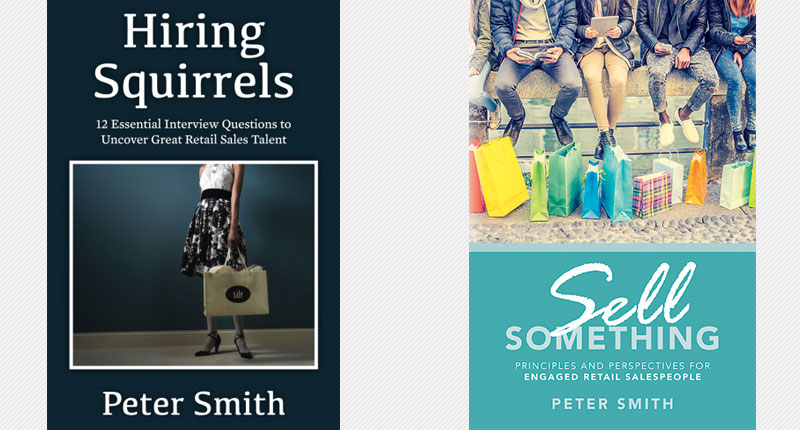Set in a Tiffany & Co. necklace, it sold for $4.2 million, the highest price and price per carat paid for a Paraíba tourmaline at auction.
Squirrel Spotting: The People Merry-Go-Round
When looking to hire or promote, jewelers need to be realistic about the fact that there will be ups and downs no matter what, Peter Smith writes.

In recent weeks, we’ve seen a shakeup of senior management at two of the jewelry industry’s biggest names.
There were multiple senior management moves at Signet, and Tiffany & Co. announced the resignation of CEO Frederic Cumenal after less than two years at the helm. That move came just a couple weeks after Tiffany announced they were parting ways with their design director, Francesca Amfitheatrof.
While we can only guess at the internal machinations that led to the departures at those two companies, what is less ambiguous is that the personnel merry-go-round, while not exclusive to our industry, seems to be in a state of constant rage.
After reading the carefully managed press releases from the two industry giants, I began to think about the madness that seems to consume companies when it comes to hiring, or promoting to, senior management positions.
While Tiffany and Signet are public companies and, as such, governed by an entirely more complex set of guidelines (they need to assuage investor confidence, for starters), the general principles remain the same for all businesses and the dangers of miscalculation are certainly not the exclusive domain of the big boys.
Unsurprisingly, companies tend to announce their new senior people with great fanfare, and the love-fest can at times border on intoxicating. We are led to believe that the marriages, if not exactly made in heaven, were at least destined by fate. Nobody on either side allows for the possibility of failure. All goals, aspirations and (ahem) previous company inefficiencies and shortcomings give way to big plans and lofty ideals.
We often hear about the costs of hiring new people--the onboarding, the training, etc. We tend to hear a good deal less about the costs of keeping the wrong people.Companies succumb to what Nobel economist Daniel Kahneman describes as the “planning fallacy.”
Kahneman writes in “Thinking Fast And Slow” that, “... they make decisions based on delusional optimism rather than on rational weighting of gains, losses, and possibilities. They overestimate benefits and underestimate costs. They spin scenarios of success while overlooking the potential for mistakes and miscalculations.”
We tend to see what we want to see when announcing important hires or promotions, and we avoid or suppress any concerns in favor of an attitude (at least outwardly) of supreme confidence in our brilliant decision making.
Cumenal had been in the Tiffany organization for a few
Staff turnover is not inherently a bad thing. We often hear about the costs of hiring new people--the onboarding, the training, etc. We tend to hear a good deal less about the costs of keeping the wrong people. While many businesses pride themselves on having people in place for years, there are, in fact, studies that show tenure as having an inverse relationship on performance.
There are also many good reasons to change leadership. Sometimes the business evolves or declines to the degree that the existing leaders are no longer well-suited to or interested in navigating the new landscape. Sometimes a change of scenery is needed for all parties, to re-energize and re-engage good people on all sides around a purpose more suited to the leader’s present circumstances and the current needs of the business.
All too often, however, the changes happen for the wrong reasons.

I am not speaking to the aforementioned companies as I don’t know the circumstances in those two cases, but I have seen what Jim Collins wrote about in “Good To Great”--the “Stockdale Paradox”-- happen far too often.
Collins was interviewing Admiral Jim Stockdale and he asked the admiral, and former longtime prisoner of war, why some people managed to survive their captivity in Vietnam better than others.
Stockdale responded by describing a paradox of optimism. He said that those prisoners who believed, without reservation, that they would be released or rescued by a specific date (I’ll be home for Christmas …) tended to fare less well than those who believed that they would eventually win their freedom but who were more pragmatic and realistic enough to recognize that putting timeframes on a situation they had no control over was unrealistic.
This became known as the “Stockdale Paradox.” In other words, it was essential for the prisoners to remain positive and optimistic to ensure that they kept themselves as physically and mentally healthy as possible under the very dire circumstances, but not to be so unrealistically optimistic that they set themselves up for failure.
We have seen this scenario all too often with companies large and small. They have an unrealistic set of expectations and they play the personnel merry-go-round convinced that their (often-blurred) vision will ultimately be realized.
Leaders, managers and employees don’t become stupid or ineffective when a business suffers setbacks. If you have aligned your personnel with the goals and values of your organization and you have given them the requisite assets and support, then get out of their way and let them do their jobs. Make sure that your people are focused on the controllables and judge them on that performance, not the things over which they have no control.
Success in sales does not mean that your people are great any more than failure means that they are bad.
The former, of course, masks a great many sins and the shortcomings (often intuitively understood) don’t become a big issue until the business hits a sustained period of failure.
On the other hand, if you are experiencing a significant run of disappointments, making hasty judgements that your people are responsible and need to be changed is not always true and it’s rarely the best thing to do for the business. If they were the right people in good times, they may well be the best opportunity for recovery in tough times.
I love Bob Rosen’s (“Grounded: How Leaders Stay Rooted in an Uncertain World”) list of how to lead with a higher purpose and we could all learn from it.
- Are my personal conduct and ethics consistent with a leader who pursues a higher purpose?
- Do I regularly refer to our higher purpose to inspire and motivate people?
- Do I tell the truth about today’s realities while trying to inspire hope for the future?
- Do I maintain a clear view of what our work means above and beyond success?
- Do I help people to see what they can do to make the world better?
Do your homework before you hire or promote a leader. If they align with your values and share your sense of purpose, then recognize that there will be peaks and valleys in performance.
When things aren’t going so swimmingly, what is needed is clear-headed, honest and pragmatic conversations about the nature of the challenges and the best course of action to correct them. Don’t undermine your people by pretending that they alone are the reason for your troubles.
Peter Smith is president of Vibhor, a public speaker and author of “Sell Something” and “Hiring Squirrels.” He spent 30 years building sales teams in retail and wholesale and he can be contacted at Dublinsmith@yahoo.com, peter@vibhorgems.com, on LinkedIn, Facebook (Hiring Squirrels), or Twitter, @Hiring Squirrels.
The Latest

The jeweler’s “Deep Freeze” display showcases its iconic jewelry designs frozen in a vintage icebox.

Take luxury gifting to new heights this holiday season with the jeweler’s showstopping 12-carat sphene ring.

How Jewelers of America’s 20 Under 40 are leading to ensure a brighter future for the jewelry industry.

This year's theme is “Unveiling the Depths of the Ocean.”


In its annual report, Pinterest noted an increase in searches for brooches, heirloom jewelry, and ‘80s luxury.

Starting Jan. 1, customers can request the service for opal, peridot, and demantoid garnet.

Roseco’s 704-page catalog showcases new lab-grown diamonds, findings, tools & more—available in print or interactive digital editions.

The new catalog features its most popular chains as well as new styles.

The filmmaker’s personal F.P. Journe “FFC” prototype was the star of Phillips’ recent record-setting watch auction in New York.

The new location in the Design District pays homage to Miami’s Art Deco heritage and its connection to the ocean.

Inflations, tariffs, and politics—including the government shutdown—were among consumers’ top concerns last month.

“Longtime favorite” presenters, as well as first-time speakers, will lead talks and workshops at the annual event in Tucson next year.

Silas Smith of Meridian Metalworks won the challenge with his pendant that blends Australian and American landscapes.

The sale of the 31.68-carat, sunset-hued stone was part of Sotheby’s first series of events and auctions in Abu Dhabi.

Most customers who walk into your store this month have made up their minds. Your job is to validate their choice, Emmanuel Raheb writes.

The collection features characters and motifs from Ukrainian folklore, including an enchanted mirror and a magic egg.

MatrixGold 3.11, the newest version of the jewelry design program, offers more flexibility, precision, and creative control.

The pavilion will be part of the 2026 JA New York Spring show, scheduled for March 15 to 17.

Kadet, a 1994 National Jeweler Retailer Hall of Fame inductee, helped grow the family-owned retailer in the Chicago area and beyond.

Billed as the world’s smallest wearable, Lumia Health’s new smart earrings have a health tracker subtly embedded in the back.

Don’t let those with December birthdays feel blue. Help them celebrate their month with blue zircon, turquoise, and tanzanite.

The new pink sapphire version of the piece dances with its wearer in the brand’s “Icons After Dark” holiday campaign.

A choice that’s generated a lot of commentary, Pantone says “Cloud Dancer” marks a fresh start and encourages relaxation and creativity.

The manufacturer’s holiday campaign features a gift guide filled with trending designs and jewelry that can be personalized.

The man was charged with theft, accused of ingesting the necklace while in a jewelry store in Auckland, New Zealand.

Sponsored by De Beers Group



























